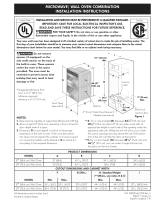
Important Notes to the InstalJer
I. Readall instructions contained in these installation
instructions before installing the wall oven.
2. Remove all packing material from the oven
compartments before connecting the electrical supply
to the wall oven.
3. Observe all governing codes and ordinances.
4. Be sure to leavethese instructions with the consumer.
5. THESEOVENS ARE NOT APPROVED FOR
STACKABLE OR SIDE-BY-SIDE INSTALLATION.
Important Note to the Consumer
Keep these instructions with your Owner's Guide for future
reference.
IMPORTANT SAFETY
INSTRUCTIONS
• Be sure your wall oven is installed and grounded
properly by a qualified installer or service
technician.
• Your wall oven must be electrically grounded in
accordance with local codes or, in their absence,
with the National Electrical Code ANSI/NFPA
No.70- latest edition in United Sates, or with CSA
Standard C22ol, Canadian Electrical Code, Part 1,
in Canada.
Stepping, leaning or sitting on the
door of this wall oven can result in serious injuries
and can also cause damage to the wall oven.
• Never use your wall oven for warming or heating
the room. Prolonged use of the wall oven without
adequate ventilation can be dangerous.
The electrical power to the oven
must be shut off while line connections are being
made. Failure to do so could result in serious
injury or death.
1. Carpentry
Refer to figure 1 or 2 for the dimensions applicable to
your appliance, and the space necessary to receive the
oven. The oven support surface may be solid plywood or
similar material, however the surface must be level from
side to side and from front to rear.
2. Electrical Requirements
This appliance must be supplied with the proper voltage
and frequency, and connected to an individual, properly
grounded branch circuit, protected by a circuit breaker or
fuse. To know the circuit breaker or fuse required by your
model, see the serial plate to find the wattage
consumption and refer to table A to get the circuit
breaker or fuse amperage.
ApplianceRating Protection ApplianceRating Protection
Watts Circuit Watts Circuit
240V recommended 208V recommendec
lessthan 4800W 20A Lessthan 4100W 20A
4800W - 7200W 30A 4100W - 6200W 30A
7200W - 9600W 40A 6200W - 8300W 40A
9600Wand + 50A 8300W and+ 50A
Table A
Observe all governing codes and local ordinances
I. A 3-wire or 4-wire single phase 120/240 or 120/208
Volt, 60 Hz AC only electrical supply is required on a
separate circuit fused on both sides of the line (time-
delay fuse or circuit breaker is recommended). DO
NOT fuse neutral. Consideration must be given for a
combination built-in oven and cooktop refer to unit
serial plate of each.
NOTE: Wire sizesand connections must conform with the
fuse size and rating of the appliance in accordance with
the American National Electrical Code ANSI/NFPA No.
70-latest edition, or with Canadian CSA Standard C22.1,
Canadian Electrical Code, Part I, and local codes and
ordinances.
An extension cord should not be used
with this appliance. Such use may result in a fire,
electrical shock, or other personal injury.
This appliance should be connected to the fused
disconnect (or circuit breaker) box through flexible
armored or nonmetallic sheathed cable. The flexible
armored cable extending from the appliance should
be connected directly to the junction box. The
junction box should be located asshown in figure 1
or 2 and with as much slack as possible remaining in
the cable between the box and the appliance, so it
can be moved if servicing is ever necessary.
3. A suitable strain relief must be provided to attach the
flexible armored cable to the junction box.












